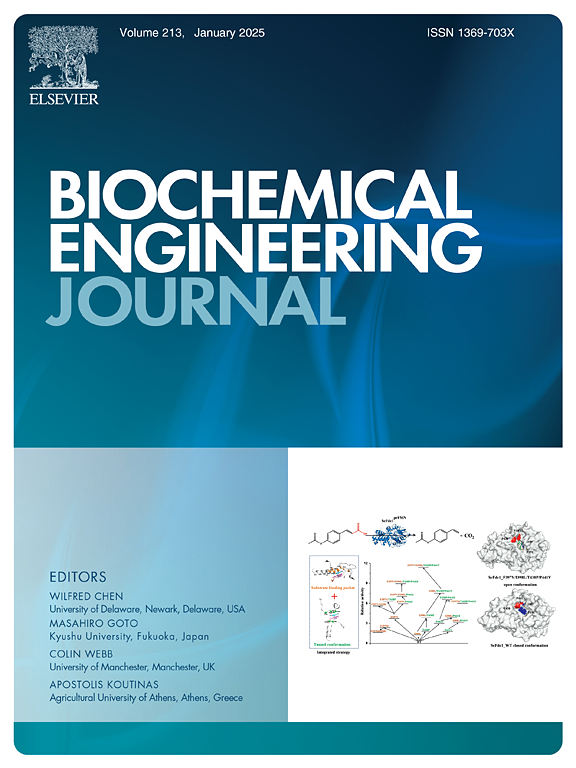开发一个可扩展的框架,以减轻高密度CHO细胞培养中的GEV和溶解的CO2压力
IF 3.7
3区 生物学
Q2 BIOTECHNOLOGY & APPLIED MICROBIOLOGY
引用次数: 0
摘要
以高密度细胞培养为特色的强化进料批凸显了生物反应器扩大规模的挑战,并强调了量身定制缓解措施的必要性,特别是在协调分散气体入口速度(GEV)和累积CO₂分压(pCO 2)引起的流体动力应力方面。在这项研究中,在2000 L一次性生物反应器(SUB)的放大过程中,GEV和pCO 2的升高被确定为滴度降低的原因。为了验证这一假设,在配备定制喷淋器的实验规模生物反应器中建立了缩小模型,以模拟高GEV和pCO 2条件。该模型再现了受损的滴度表现,表明这两个因素通过独立的机制和培养阶段依赖的方式抑制了生产。蛋白质组学分析进一步揭示了与细胞增殖、能量产生和活性氧诱导的细胞反应相关的蛋白质表达差异。最后,通过改进的2000 L SUB和升级的分离器设计,实现了一种优化的放大策略,平衡了有效的pCO2汽提和可控的GEV应力。这项工作阐明了pCO2升高和GEV应力与培养性能之间的相互作用,建立了一个系统的框架来调节GEV和pCO2,作为一个通用的放大工具。这些发现为所有哺乳动物细胞培养提供了扩大规模的策略,特别是对剪切应力和/或pCO 2敏感的细胞系,同时加强了对工业应用中生物过程可扩展性的机制见解。本文章由计算机程序翻译,如有差异,请以英文原文为准。
Developing a scalable framework for mitigating GEV and dissolved CO2 stresses in high-density CHO cell cultures
Intensified fed-batch featuring high-cell-density cultures highlights challenges in bioreactor scale-up and underscores the needs for tailored mitigation, particularly on the reconciliation of the hydrodynamic stress from sparger gas entrance velocity (GEV) and accumulated CO₂ partial pressure (pCO₂). In this study, elevated GEV and pCO₂ were identified as the causes of titer reduction during the scale-up to a 2000 L single-use bioreactor (SUB). To verify this hypothesis, a scaled-down model was established in bench-scale bioreactors equipped with a customized sparger to simulate the high GEV and pCO₂ conditions. The model reproduced the impaired titer performance, showing that both factors inhibited production through an independent mechanism and a culture phase-dependent manner. Proteomic analysis of the two stresses further revealed differentially protein expressions associated with cell proliferation, energy generation and reactive oxygen species induced cellular responses. Lastly, an optimized scale-up strategy balancing effective pCO2 stripping with controlled GEV stress was implemented through a modified 2000 L SUB with an upgraded sparger design. This work elucidated the interplay between elevated pCO2 and GEV stresses and culture performance, establishing a systematic framework for modulating GEV and pCO₂ as a universal scale-up tool. The findings advanced scale-up strategies for all mammalian cell cultures, especially for shear stress- and/or pCO₂-sensitive cell lines, while reinforcing mechanistic insights into bioprocess scalability for industrial applications.
求助全文
通过发布文献求助,成功后即可免费获取论文全文。
去求助
来源期刊

Biochemical Engineering Journal
工程技术-工程:化工
CiteScore
7.10
自引率
5.10%
发文量
380
审稿时长
34 days
期刊介绍:
The Biochemical Engineering Journal aims to promote progress in the crucial chemical engineering aspects of the development of biological processes associated with everything from raw materials preparation to product recovery relevant to industries as diverse as medical/healthcare, industrial biotechnology, and environmental biotechnology.
The Journal welcomes full length original research papers, short communications, and review papers* in the following research fields:
Biocatalysis (enzyme or microbial) and biotransformations, including immobilized biocatalyst preparation and kinetics
Biosensors and Biodevices including biofabrication and novel fuel cell development
Bioseparations including scale-up and protein refolding/renaturation
Environmental Bioengineering including bioconversion, bioremediation, and microbial fuel cells
Bioreactor Systems including characterization, optimization and scale-up
Bioresources and Biorefinery Engineering including biomass conversion, biofuels, bioenergy, and optimization
Industrial Biotechnology including specialty chemicals, platform chemicals and neutraceuticals
Biomaterials and Tissue Engineering including bioartificial organs, cell encapsulation, and controlled release
Cell Culture Engineering (plant, animal or insect cells) including viral vectors, monoclonal antibodies, recombinant proteins, vaccines, and secondary metabolites
Cell Therapies and Stem Cells including pluripotent, mesenchymal and hematopoietic stem cells; immunotherapies; tissue-specific differentiation; and cryopreservation
Metabolic Engineering, Systems and Synthetic Biology including OMICS, bioinformatics, in silico biology, and metabolic flux analysis
Protein Engineering including enzyme engineering and directed evolution.
 求助内容:
求助内容: 应助结果提醒方式:
应助结果提醒方式:


